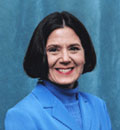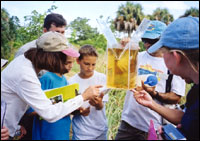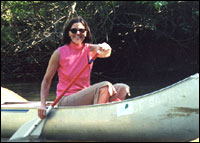The people who make policy don’t always make headlines. The Bush administration boasts more than a few strong-minded, behind-the-scenes strategists with almost as much influence as cabinet members. Lynn Scarlett is one of them. As assistant secretary of the Department of Interior’s Office of Policy, Management, and Budget, Scarlett helps determine the budgets for all eight DOI bureaus — from Fish and Wildlife to the Minerals Management Service. Her office performs background analysis on every revised rule and new program that passes through the agency. That makes her the only person in Interior, aside from Secretary Gale Norton and Deputy Secretary Steven Griles, whose responsibilities are cross-departmental.

Lynn Scarlett.
Photo: DOI.
In other words, Scarlett knows a thing or two about the ins and outs of the Bush administration’s environmental policy. And as former director of the Reason Foundation, a libertarian think tank, she has strong opinions about the ideology behind that policy. Scarlett staunchly defends Bush’s environmental policy as a shift toward more sophisticated environmental governance — an approach she calls the “new environmentalism.” Although aspects of this approach are ambitious and intriguing, it is based on some assumptions and strategies that environmentalists doubt, fear, and ridicule.
In an effort to bridge the hostile divide between the powers that be and the environmental community, Grist tracked down Scarlett during a recent visit to her hometown of Santa Barbara, Calif., to discuss the philosophy of rollbacks, the invisible hand’s “green thumb,” her view on public comments, and life with her solar-activist husband.
Hi! It’s Lynn Scarlett. I am driving through Santa Barbara at the moment and the connection may get spotty. I’ll just pull off onto the shoulder when I get a good signal if it does.
Great, thanks. If you were to give the Bush administration a letter grade for its environmental record, what would it be?
I think letter grades are not particularly meaningful. What this administration is trying to do is move in a new direction — beyond the punitive, prescriptive regulations of the last 30 years — to include programs that engage local communities in environmental stewardship and stimulate markets in the direction of environmental innovation. If you were to ask me how well we’re doing in trying to move along that trajectory, I would say in the short time that this administration has been in place, we’ve done an awful lot. There’s no end point here. This is a journey, not a destination.

Not just kidding around: Scarlett engages in some outdoor education.
Photo: DOI.
Critics generally describe the “awful lot” you’ve done as literally awful. What is your response to the fact that Republicans and Democrats alike are calling this administration’s environmental record the worst in history?
I am, of course, very aware that there are criticisms out there by many in the environmental community. But much of that, in my perspective, is a function of some environmental activists seeing only what they are looking for. I think one of the shortcomings of the environmental community is that after Earth Day 1970, many folks turned their eyes to Washington to resolve our environmental problems, and haven’t been able to expand their perspective. They put all of their eggs in the Washington regulatory basket. For 30 years, they tended to look at large national statutory changes as the predominant bellwether of environmental success.
And still, despite the sea change in national awareness and corporate practices and community efforts that has since swept through America, some of the environmental community maintains this belief that that if we don’t keep heaping more regulations onto the statutory framework of the past, we’ll be going to heck in a handbasket.
But there are mountains of evidence that these regulations have yielded dramatic improvements in America’s environmental quality over the last 30 years.
There’s no question that those statutes yielded success. At a very minimum, they touched off a kind of national awareness that has in and of itself brought about change. The standards themselves helped to pull our actions in companies and on farms and in factories to a new level of awareness and behavior.
What was overlooked, as people turned their eyes to Washington, was the unfolding story of a new era of environmental entrepreneurship, citizen stewardship, the sort of Aldo Leopold vision of a nation of stewards. And we began to see more and more folks adopting [that vision], not simply in their backyards, not simply in partnership with nonprofits, but also [in] companies.
Can you explain this notion of environmental entrepreneurship?
From the dawn of the industrial era to the present, manufacturers have continuously sought ways to “do more with less” — it’s an intrinsic part of the competitive quest to cut costs and/or add value to customers. In other words, to a certain extent, Adam Smith’s “invisible hand” has a green thumb.
We’re seeing it today more than ever — technological wonders that have allowed people to communicate and companies to operate more quickly and reliably, and with far fewer resources for each consumption unit. A single CD-ROM, for example, can carry 90 million phone numbers, replacing five tons of phone books. A mere 65 pounds of silica can create a fiber-optic cable that carries 40 times the messages of a cable made from one ton of copper. I believe free markets and industry are on a trajectory toward improved environmental performance. I do not believe, as many in the environmental community argue, that the whole 150 years of industrialization have been the beginning of the end.
This theory is compelling, and yet at the same time, it’s fundamentally cheaper in the near-term for power plants to pollute and for companies to dump hazardous waste rather than deal with it safely. Many companies have very obvious disincentives to clean up.
You’re absolutely right that there are certain realms of activities where we cannot lose sight of the importance of having certain performance standards and then monitoring and enforcing them.
What are the areas where you think regulations and enforcement are not necessary?
Well, really, I don’t think it’s a matter of that area or this area. We have existing benchmark performance standards in all realms, whether it’s hazardous waste or air quality or water quality. We have set our sights on certain quality standards that are important to ensuring human health and protection of environmental resources. The real question is not either/or. The real question is: Okay, we have those standards, but going forward, do we want to diversify our approach?
We have to recognize that there are shortcomings to standards. First, a standard is a ceiling: Companies move to meet the standard and stop there, without any incentive to go further and innovate. Second, standards often include technical prescriptions, saying you need to have such and such a device on your facility to meet the standard rather than encouraging companies to innovate, rather than encouraging them to come up with ever-more sophisticated methods of achieving those standards. In this regard, regulations tend to curtail creativity and innovation.
Just think of the way, by analogy, most of us raise our families. Sure, you hold out some discipline for your children, but for the most part we try to inspire them to be flourishing young people through being role models, through encouragement, through exciting them about opportunities in the world before them.
I’ve never known an environmentalist to be opposed to carrots or environmental innovation of any kind. That’s why many support cap-and-trade systems for certain pollutants and programs like Energy Star that reward businesses that innovate. But human nature dictates that carrots need to be combined with sticks. Kids are not going to clean up their rooms unless you tell them to, and companies are not going incur the costs required to innovate unless standards exist and are strongly enforced. And yet, critics argue that under the Bush administration the sticks are being all but smashed to smithereens.
There’s no question that there’s an emphasis on the carrot. And I think that the time is right for that emphasis. But if you really look at a lot of the issues [with Bush administration policies] that some in the environmental community have raised, very few of them, if any, are about changing or eliminating or reversing existing air standards or water standards or hazardous-waste standards. There is an edifice out there of standards, virtually all of which remain in place. A lot of the controversies have been around what’s the next step in standards — do we add an additional increment in such and so emission or do we add an additional type of emission to the suite of things we already regulate? Or do we invest our energy in bigger-bang achievements that come from cooperative conservation?
The concern of the environmental community is that the existing regulatory changes are not being left in place, but rather seriously dismantled. As you know, environmental organizations have been keeping a tally of the regulatory rollbacks and they number over 500. How do we make sense of that?
In part, this may be a matter of interpretation. Many of the most controversial of these issues have related to regulations that were proposed in the last few months of the Clinton administration that had yet to go into effect before we reconsidered them. In many instances, we have undertaken no changes; in others, such as the rule on diesel emissions, the administration has adopted strict standards.

Appreciating the silent wonders of Yellowstone.
Photo: NPS.
Why did the Department of the Interior reverse the Clinton administration’s decision to ban snowmobiles in Yellowstone? And why did the courts then decide to reverse Interior’s position?
The decision
may face an appeal, so this is not a done deal yet and we’ll have to look forward to the ultimate outcome. But I’m happy to review why we believe that the previous administration’s decision warranted reconsideration: You have a national park statute that requires that parks are managed to both protect the resources of the park and, on an equal plane with that, provide recreational opportunities and visitor enjoyment of the parks.
In the case of Yellowstone, this is where there has been snowmobile use for many, many years. The snowmobiles presented challenges of noise and air quality and there were concerns that they created highways for the bison and therefore moved bison out of the park. The Clinton administration’s response was to ban snowmobiles. We thought the challenges deserved a closer look and a more nuanced approach. So what we proposed is a rule that results in 70 to 90 percent reduction of emissions by the vehicles by virtue of requiring that only snowmobiles that meet specific noise standards and air quality standards will be allowed in the parks. We also created strong restrictions about where in the parks the snowmobiles could go, as well as a cap on numbers of snowmobiles that could enter the park at any point in time.
My understanding was that your proposed rule only called for the best available technology, which would actually have far less dramatic emissions reductions than you claim.
There have been [snowmobile] prototypes developed that suggest that these kinds of reductions are possible. The proposal is indeed based on the best available technologies with the snowmobiles proposed for use expected to result in emission reductions of 70 to 90 percent. Moreover, the rule proposed an adaptive management program to assess the effectiveness of the measures and make any needed adjustments to make sure park goals are met.
Regardless, critics are concerned that more than 80 percent of the public comments were strongly opposed to allowing snowmobiles in Yellowstone.
Our decision as land-use planners is not simply a matter of what I might characterize as a popularity contest — you get 52 cards in saying this and 22 saying that, then you do this. Those comments become part of what is considered in the determination along with looking at the statute and the science. We have to balance all that and weigh that and then come up with a judgment as administrators of what we think will achieve the best mix of benefits for the public.
I don’t really want to dwell on the postcard issue because then this will become a “postcards don’t count” kind of discussion. These public comments are important, but there are many specific organizations, shall we put it this way, that have become very good at and very used to using that process. And so they use that process to make their voice heard and therefore those voices tend to have a prominence in certain comments. But we have to look at all Americans, not just those who have become well-versed in using that emailing or post-card commenting process.
The media has reported that the air quality in Yellowstone has gotten so bad that the attendants have to wear gas masks.
I think some of those reports have been misleading. Yellowstone is 2 million acres or thereabouts. That’s really big. We think it’s possible to have some snowmobile use and at the same time have provisions that reduce noise, that reduce air-quality impacts, and that protect resources. Remember this also: There are a lot more automobiles that travel thorough Yellowstone any given day in the spring, summer, or fall than there are snowmobiles in the winter. So the challenge is, whether it’s automobiles in the summer or snowmobiles in the winter, is there a way to let people have access but to try and lighten the environmental footprint?
What is your response to concerns that the Healthy Forests initiative gives loggers an opportunity not just to clean out flammable materials that would make forests more prone to fire, but also to log old-growth trees?
I don’t think you’ll find substance in the act that bears out those claims. This legislation went through the congressional process with all manner of give and take until we got a bipartisan bill that passed. This legislation is based on research into disease-infested forest and on removal of underbrush and selectively removing certain trees in areas that have densities that are 10 to 20 times more than historic densities. That research shows that these conditions are resulting in fires of unnatural scope and producing unprecedented risk to communities.
The concern is that there are loopholes that will allow the logging industry to remove trees that have nothing to do with forest fire — that are in fact so big and old their bark is fire-retardant.
Most of what the legislation calls for is reducing brush and selectively removing densely packed or diseased trees. A lot of this effort occurs through controlled burns. I’ve been out there on these thinning projects and sometimes they are taking out some trees, but that’s only when the trees are four feet apart, instead of, say, 20 feet apart, which is what they might have been historically. What that means is that you have far more trees in a given space sucking up very scarce water in very dry Western hydrologic conditions. That means they become very much more prone to disease and they can’t grow big and have the same kinds of crowns that naturally they would have.
What is your response to critics’ concerns about ties to industry within the Bush administration? Is it fair to assume that a longtime history as an industry lobbyist — say, in the case of Steven Griles — indicates a bias?
If you actually look at the people this president has appointed, they represent a broad array of backgrounds as public-sector lawyers, think-tank analysts, and some have backgrounds working with companies. What we see in the media is that people’s backgrounds are weighted heavily toward industry, and that’s not a true reflection of the mix of appointees. And those people who do have backgrounds with the private sector, that’s a good thing, because that gives them substantial management backgrounds and knowledge. The problem is that many of the critics have looked very selectively and focused only on those in industry, and said “A-ha! This is evidence of a uni-dimensional perspective.”
But many of those with industry backgrounds are in the highest-level positions making huge and far-reaching decisions, including your bosses, Gale Norton and Griles. Not to mention the president and vice president.
The idea that somehow the ideas that someone has are simply a reflection of who they worked for — as opposed to having some other knowledge base and framework — is a mistake. It’s a very simplistic notion to assume that the world is made up of some abstract group called industry that has, lock, stock, and barrel, the same policy perspectives on any issue. Just as it would be a mistake to say everyone who holds dearly environmental values — whether they’re from The Nature Conservancy or the Natural Resources Defense Council or Ducks Unlimited — hold the same perspective on everything.

Life is but a dream.
Photo: DOI.
What is your personal connection to the environment?
The very first connection is probably my mother, who is an avid bird watcher. So from the time I was able to hold binoculars, maybe 7 years old, she would take me and my three sisters bird watching. All of us have been avid birders virtually our entire lives. Apart from that enduring passion, I was a competitive swimmer in my youth and I trained in lakes in Canada. I would go up in the summer to a camp north of Toronto where we would work out in the lakes and interspersed with that go on canoe trips that took us across literally hundreds of miles of lakes. So I grew up loving that.
Then I came to U.C.-Santa Barbara and this is a wonderful place to be, with Los Padres National Forest looming up behind the town. I became an avid hiker in the mountains behind Santa Barbara. Then I went to school in Switzerland and Austria, so I climbed many of the Alpine peaks and glaciers. Hiking is what I do. It’s what I enjoy.
So I suppose Washington, D.C., doesn’t present as many good hiking opportunities?
You’d be surprised. There’s Prince William Forest National Park 40 minutes away from where I live — fantastic trails! — and within an hour and a half there’s Shenandoah National Park and then George Washington National Forest. I hike in all those places. I mean, I’ve hiked the more popular areas right near Washington, D.C. — the Billy Goat Trail and some others — but it’s not my preference. When I hike I like to go 12, 13 miles. Not two.
Can you talk about your living habits?
In Santa Barbara, we don’t use air conditioning or heating. In the winter, we always keep our house in the 60s. We have two-thirds of an acre that we live on and we use a lot of native plants. We have a creek and we restored all the native vegetation, so it’s all natural and we removed the invasive species. It’s sort of our pride and joy.
What kind of car do you drive?
My husband has a Grand Am — a Pontiac. And I have a Ford Taurus. No SUVs. They’re sort of affordable cars — that’s how I’d categorize them.
I understand that your husband has devoted his career to advocating for solar energy.
He worked for the second-largest distributor of solar PV [photovoltaic] systems in the U.S. for a long time and he was also president of the California Solar Energy Association for several terms.
Do you share similar views on environmental policy? Or are you more like Mary Matalin and James Carville?
No, he shares my perspective. In fact, one of his frustrations with the solar world is that he thinks there have been a lot of missed opportunities precisely because people have tried to shoehorn solar into uses where it’s least effective, rather than focusing on building those markets where it’s most effective. For example, people trying to get subsidized projects for solar rooftops in urban areas — he would argue that that’s its most costly application. We would be far better off promoting its uses for things like solar irrigation pumping systems, for bus stop lighting, for cellular repeater sites, for all the kinds of uses where it’s really cost-effective. The idea is that rather than trying to force it into one particular kind of use, work on letting it emerge where it really makes sense. Then it will increasingly become affordable for larger-scale applications.
I’d like to end by asking whether you’d prefer to have dinner with environmental advocate Robert Redford or Leo DiCaprio?
Oh my goodness! Ah! I have no idea. [Laughter.] Not being someone prone to reading People magazine, I’m not sure that I know very much about these individuals. Well, I guess I do know about Sundance — that place Robert Redford has, that conference center he has, and I’ve been to a conference there. I really have no idea. You know, I’m particularly interested in people who have vigorous ideas. And since I’ve never had a conversation with either or read anything by either, I have no idea whether they have those ideas or not.


